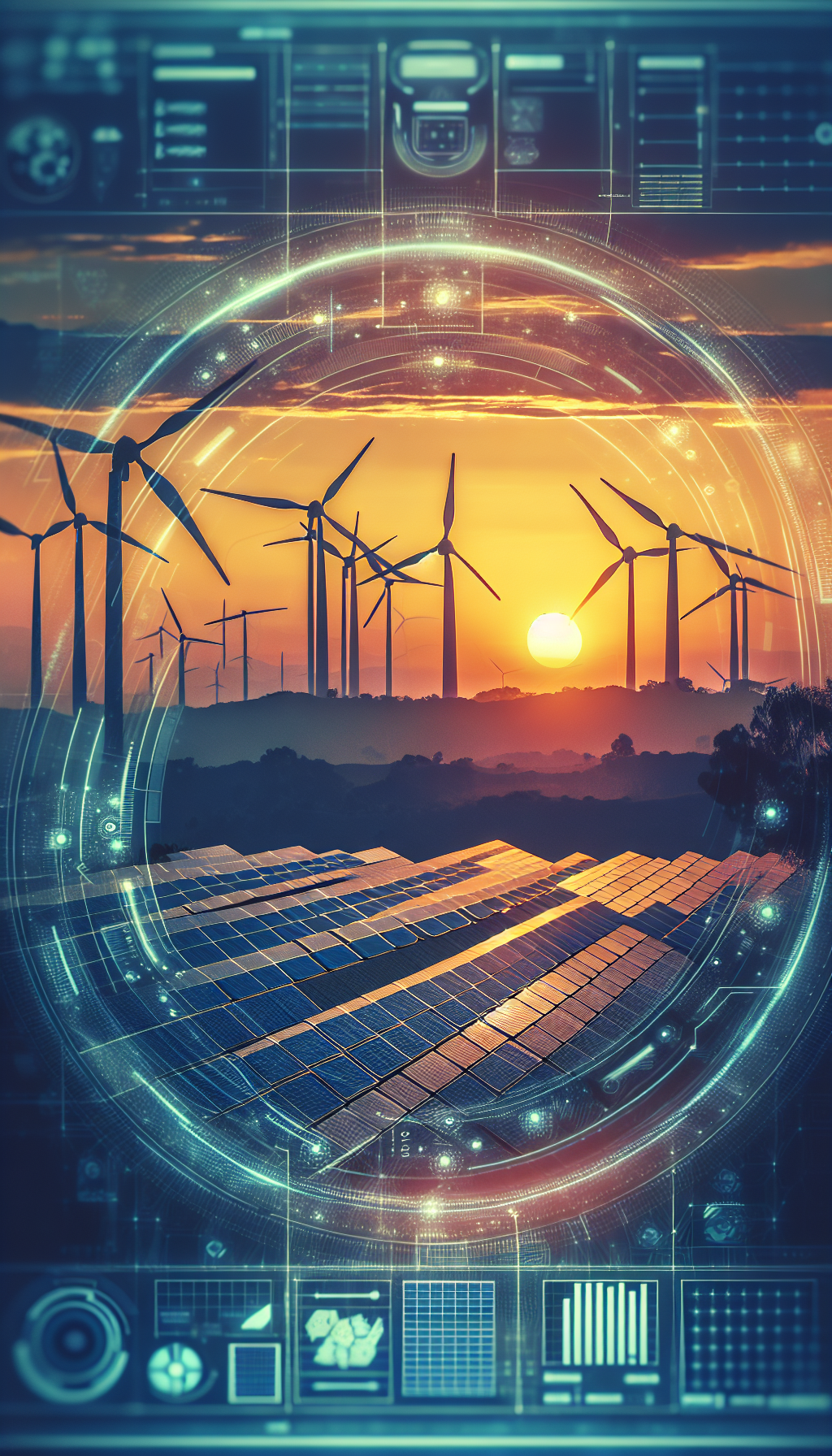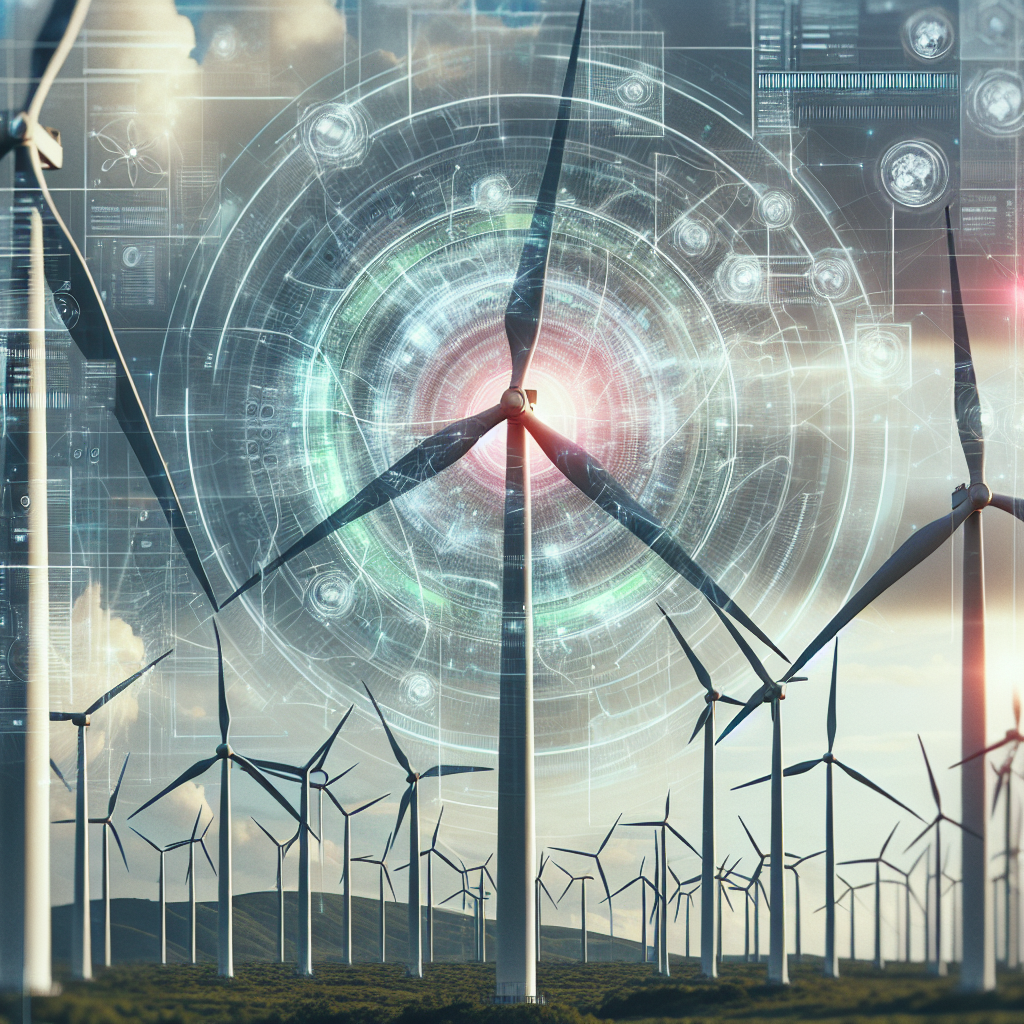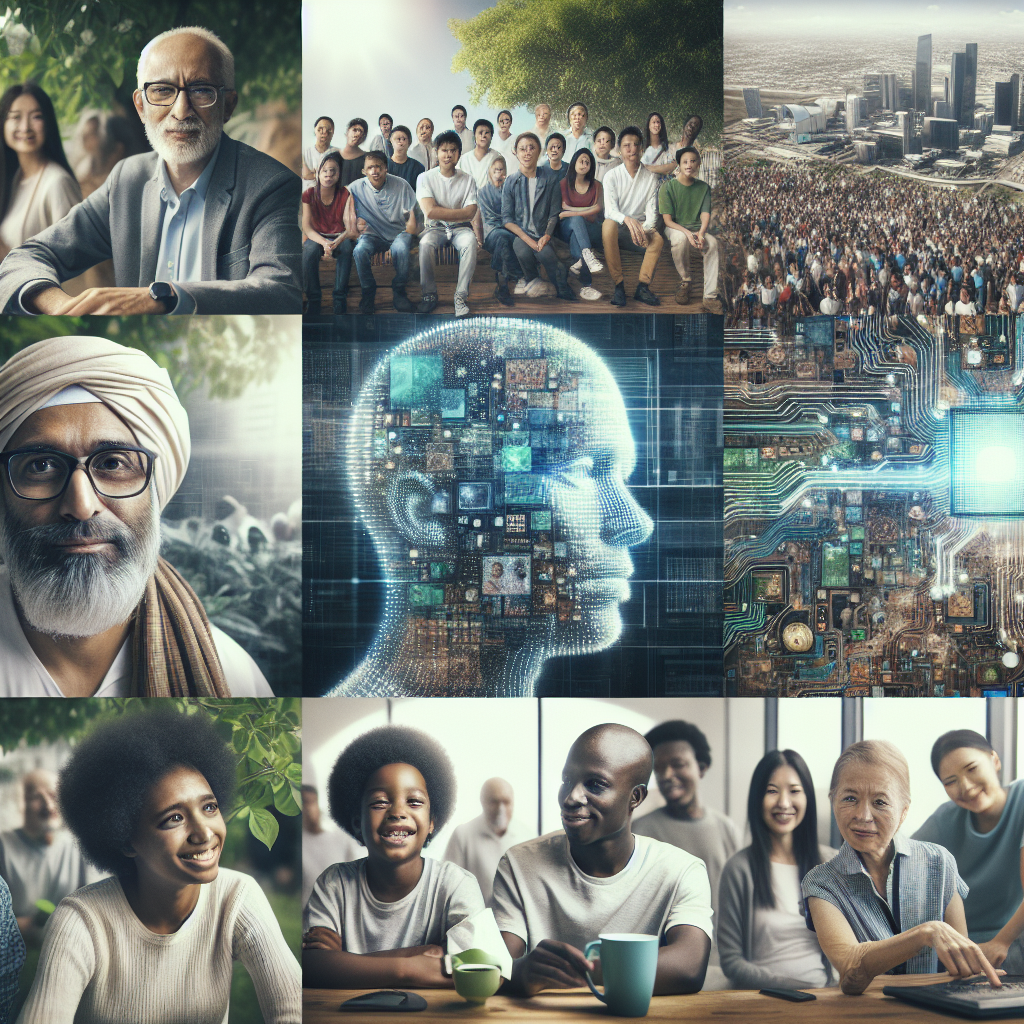The Intersection of AI and Sustainability
The integration of Artificial Intelligence (AI) in sustainability efforts marks a transformative shift in how we approach environmental challenges. AI technologies are increasingly being harnessed to optimize processes, reduce waste, and enhance the efficiency of systems that are crucial for achieving carbon neutrality. The intersection of AI and sustainability is evident in various sectors, where AI-driven solutions provide innovative ways to tackle complex issues related to energy consumption, resource management, and emissions reduction.
One of the most significant contributions of AI to sustainability is in the realm of renewable energy. AI algorithms are used to predict energy production from renewable sources such as solar and wind, which are inherently variable. By analyzing weather patterns and historical data, AI can forecast energy output and optimize grid operations, ensuring a stable and reliable supply of clean energy. This not only enhances the efficiency of renewable energy systems but also reduces reliance on fossil fuels.
In addition to renewable energy, AI plays a crucial role in developing smart grids. Smart grids utilize AI to monitor and manage the flow of electricity from producers to consumers, optimizing energy distribution and minimizing losses. This technology allows for real-time adjustments to energy supply and demand, reducing energy wastage and lowering carbon footprints. AI-driven smart grids also support the integration of electric vehicles and other sustainable technologies, further contributing to a carbon-neutral future.
Moreover, AI supports carbon capture and storage (CCS) technologies, which are vital for reducing greenhouse gas emissions from industrial processes. AI models can enhance the efficiency of carbon capture systems by predicting and optimizing the conditions under which carbon dioxide can be most effectively captured and stored. This capability is critical for industries seeking to mitigate their environmental impact while maintaining productivity.
AI in Renewable Energy Optimization
Artificial Intelligence (AI) plays a transformative role in optimizing renewable energy systems, enhancing their efficiency and reliability. By leveraging the power of AI, renewable energy technologies such as solar, wind, and hydroelectric power are experiencing significant advancements. AI algorithms can predict energy production and consumption patterns, enabling smarter integration of renewable energy sources into the grid.
One of the primary applications of AI in renewable energy is in forecasting. AI models analyze vast datasets, including weather patterns, historical energy consumption, and market trends, to accurately predict energy output from renewable sources. This predictive capability helps in balancing supply and demand, reducing reliance on fossil fuels.
- Improved accuracy in weather forecasting for solar and wind energy.
- Optimization of energy storage systems to ensure a stable energy supply.
- Real-time monitoring and diagnostics of renewable energy equipment.
AI also facilitates the optimization of energy storage systems. By predicting periods of high and low energy production, AI can efficiently manage energy storage, ensuring that excess energy is stored and used during times of low production. This not only stabilizes the energy supply but also maximizes the utilization of renewable resources. Moreover, AI-driven analytics are crucial for the real-time monitoring and maintenance of renewable energy systems, identifying potential issues before they lead to failures and costly downtimes.
Smart Grids and AI: Enhancing Efficiency
The integration of Artificial Intelligence (AI) into smart grid technology is revolutionizing the way we manage and distribute energy, enhancing both efficiency and sustainability. By leveraging AI, smart grids can optimize energy consumption, predict demand fluctuations, and integrate renewable energy sources more effectively. This results in a more resilient and flexible energy system capable of meeting the dynamic demands of modern societies while minimizing environmental impact.
AI-Driven Demand Prediction is one of the key areas where smart grids benefit significantly. AI algorithms analyze vast amounts of data from various sources, such as weather forecasts, historical consumption patterns, and real-time grid conditions, to accurately predict energy demand. This enables utility companies to adjust production and distribution in real time, reducing waste and ensuring a stable supply. A study found that AI-enhanced smart grids can improve demand prediction accuracy by up to 20%, which translates to substantial cost savings and reduced carbon emissions.
Another important aspect is the integration of renewable energy sources. Smart grids equipped with AI can seamlessly incorporate solar and wind energy by predicting availability and adjusting the grid’s operations accordingly. AI algorithms can quickly process data from solar panels and wind turbines, allowing for real-time adjustments that maximize energy utilization and minimize reliance on fossil fuels. The result is a significant reduction in greenhouse gas emissions, as shown in the following data visualization:
| Energy Source | AI Integration Impact on Emissions (Reduction %) |
|---|---|
| Solar | 25% |
| Wind | 30% |
Furthermore, AI enhances grid resilience and fault detection. Machine learning models can identify patterns that precede equipment failures or outages, allowing for preventive maintenance and rapid response. This capability not only improves reliability but also reduces the carbon footprint associated with emergency repairs and grid downtime. In summary, the application of AI in smart grids plays a pivotal role in enhancing energy efficiency, integrating renewables, and maintaining a sustainable and reliable energy infrastructure.
AI-Driven Carbon Capture Technologies
Artificial Intelligence (AI) is revolutionizing carbon capture technologies, offering innovative solutions that enhance efficiency and scalability. By leveraging AI, researchers and industries can optimize carbon capture processes, reducing costs and improving the overall effectiveness of these technologies. AI algorithms are particularly effective in analyzing complex data sets, enabling the prediction and modeling of carbon capture processes with unprecedented accuracy. This capability allows for real-time adjustments and improvements in carbon capture systems, making them more adaptable to varying environmental conditions and industrial requirements.
One of the key areas where AI is making an impact is in the optimization of materials used in carbon capture. Machine learning models can predict the performance of different materials in capturing CO2, enabling the development of more effective and sustainable options. For instance, AI can analyze numerous variables, such as temperature, pressure, and chemical composition, to identify the most suitable materials for specific applications. This process not only accelerates the research and development phase but also significantly cuts down on the experimentation costs traditionally associated with material science.
Moreover, AI-driven predictive maintenance plays a crucial role in ensuring the reliability and efficiency of carbon capture systems. By utilizing AI to monitor equipment and systems, potential failures can be anticipated and addressed before they lead to significant downtime or inefficiencies. This proactive approach not only enhances the operational longevity of carbon capture technologies but also ensures they operate at optimal performance levels. The integration of AI in maintenance strategies exemplifies a shift towards more intelligent and responsive industrial systems.
The following table illustrates the potential impact of AI on different aspects of carbon capture technologies:
| Aspect | Impact of AI |
|---|---|
| Material Optimization | Enhanced prediction capabilities for selecting effective materials, reducing development time and costs. |
| System Efficiency | Real-time data analysis and process adjustments, leading to higher capture rates and lower energy consumption. |
| Predictive Maintenance | Early detection of potential failures, minimizing downtime and extending equipment lifespan. |
- Enhanced prediction capabilities
- Real-time data analysis
- Proactive maintenance strategies
AI for Sustainable Transportation Solutions
Artificial Intelligence (AI) is revolutionizing the transportation sector by enabling more sustainable and efficient systems. The integration of AI technologies in transportation is not only reducing carbon emissions but also improving the overall efficiency of transport systems. AI-driven innovations such as autonomous vehicles, traffic management systems, and smart logistics are at the forefront of this transformation. These technologies leverage AI algorithms to optimize routes, reduce fuel consumption, and minimize idle times, thereby contributing significantly to carbon neutrality.
Autonomous Vehicles: The development of autonomous vehicles is a major leap towards sustainable transportation. These vehicles use AI to navigate and make real-time decisions, which improves fuel efficiency and reduces emissions. A study shows that autonomous vehicles could reduce fuel consumption by up to 10%. Additionally, they can optimize traffic flow, leading to less congestion and lower pollution levels.
Smart Traffic Management: AI-powered traffic management systems are essential in creating sustainable urban environments. By analyzing traffic patterns and predicting congestion, AI systems can optimize traffic signals and reroute vehicles to avoid delays. This not only cuts down on the time vehicles spend idling but also decreases emissions significantly. For instance, cities that have implemented AI traffic management systems have seen a reduction in traffic congestion by 15-20%.
Furthermore, AI is playing a crucial role in enhancing smart logistics. By employing AI algorithms, logistics companies can optimize delivery routes and schedules, reducing the carbon footprint of transportation fleets. AI tools assist in load optimization and predictive maintenance of vehicles, which prolongs vehicle life and reduces unnecessary fuel consumption. Such advancements are vital for moving towards carbon neutrality.
Predictive Maintenance and AI for Green Manufacturing
Predictive maintenance, powered by artificial intelligence, is transforming the landscape of green manufacturing by enhancing efficiency and reducing waste. The integration of AI in predictive maintenance allows manufacturers to foresee potential equipment failures before they occur, minimizing downtime and extending the lifespan of machinery. This proactive approach not only conserves resources but also supports the principles of sustainability by reducing the need for frequent replacements and repairs.
AI-driven predictive maintenance employs machine learning algorithms to analyze data collected from various sensors embedded in manufacturing equipment. These sensors monitor parameters such as temperature, vibration, and sound, providing real-time insights into the health of machinery. For instance, AI can predict the remaining useful life of a machine component, allowing for timely maintenance interventions. This advancement significantly contributes to a reduction in energy consumption and operational costs, aligning with carbon-neutral goals.
Furthermore, AI technologies facilitate the optimization of manufacturing processes, leading to greener production methods. By analyzing vast datasets, AI can identify patterns and recommend adjustments to enhance energy efficiency. Consider the following benefits of AI in predictive maintenance for green manufacturing:
- Reduction in unexpected equipment failures
- Lower maintenance costs and resource usage
- Improved energy efficiency and reduced carbon emissions
A study conducted on manufacturing plants implementing AI-based predictive maintenance demonstrated a 20% increase in equipment uptime and a 30% reduction in maintenance costs. The table below highlights key performance indicators before and after the integration of AI:
| Performance Indicator | Before AI Implementation | After AI Implementation |
|---|---|---|
| Equipment Uptime | 75% | 95% |
| Maintenance Costs | $100,000 | $70,000 |
| Energy Consumption | 500,000 kWh | 350,000 kWh |
In conclusion, the adoption of AI in predictive maintenance is a crucial step towards achieving sustainability in manufacturing. By enhancing operational efficiency and reducing environmental impact, AI not only supports green manufacturing but also accelerates the transition to carbon-neutral technologies.
AI in Agriculture: Reducing Carbon Footprint
Artificial Intelligence (AI) is revolutionizing agriculture by enhancing productivity while reducing the carbon footprint. In the quest for carbon neutrality, agriculture is a critical sector that significantly contributes to greenhouse gas emissions. However, AI technologies are paving the way for more sustainable practices. By leveraging AI, farmers can optimize resource usage, predict weather patterns, and improve crop yields, all of which contribute to a reduced environmental impact.
One of the key applications of AI in agriculture is precision farming. This approach utilizes AI-driven analytics to make informed decisions about planting, fertilizing, and harvesting. Precision farming reduces the use of fertilizers and pesticides, thereby lowering emissions. For instance, AI algorithms can analyze soil data to determine the exact amount of nutrients needed, minimizing excess use. This not only enhances soil health but also decreases the release of harmful chemicals into the environment.
Moreover, AI is instrumental in optimizing irrigation processes. By analyzing weather forecasts and soil moisture levels, AI systems can automate irrigation schedules, ensuring efficient water usage. This is crucial in regions affected by water scarcity and contributes to reducing the energy consumption associated with water pumps. Efficient irrigation management thus plays a significant role in minimizing the carbon footprint of agricultural activities.
The implementation of AI in agriculture also extends to supply chain optimization. AI-driven platforms enable farmers to predict demand, manage inventory, and reduce waste. This not only enhances economic efficiency but also reduces emissions related to transportation and storage. By improving supply chain efficiency, AI helps lower the overall carbon emissions of the agricultural sector.
AI-Powered Energy Storage Solutions
AI-powered energy storage solutions are becoming increasingly vital in the transition towards carbon neutrality. These systems leverage artificial intelligence to optimize the efficiency and reliability of energy storage technologies, such as batteries and thermal storage. By analyzing large datasets from energy production and consumption patterns, AI algorithms can predict demand surges and adjust the storage and release of energy accordingly. This ensures a more balanced grid and reduces the reliance on fossil fuels during peak times, ultimately contributing to a decrease in carbon emissions.
One of the major benefits of AI in energy storage is its ability to enhance the performance of renewable energy sources like solar and wind. These sources are inherently variable and unpredictable, but with AI, storage systems can be programmed to store excess energy generated during periods of high production and release it when production is low. This optimization not only improves the efficiency of renewable energy systems but also makes them more economically viable. As a result, AI-driven storage solutions are crucial for maximizing the potential of renewable energy and supporting the grid’s stability.
Furthermore, AI systems facilitate the predictive maintenance of energy storage units, reducing downtime and operational costs. By employing machine learning models, operators can foresee potential failures or necessary maintenance before they occur. This predictive capability minimizes unexpected outages and extends the lifespan of storage infrastructure. The table below illustrates some key advantages of AI-powered energy storage:
| Advantage | Description |
|---|---|
| Efficiency Optimization | AI algorithms balance energy storage and release, ensuring optimal grid performance. |
| Enhanced Renewables | Improves the viability and efficiency of solar and wind energy by managing variability. |
| Predictive Maintenance | Reduces downtime and costs by predicting potential issues before they occur. |
In conclusion, AI-powered energy storage solutions are indispensable in the pursuit of carbon neutrality. By enhancing the efficiency and reliability of renewable energy systems and reducing operational costs through predictive maintenance, AI plays a pivotal role in advancing sustainable energy technologies. As these solutions continue to evolve, they promise to significantly accelerate the transition to a cleaner, more sustainable energy future.
AI in Urban Planning for Sustainable Cities
Artificial Intelligence (AI) is becoming an indispensable tool in urban planning, particularly for the development of sustainable cities. The integration of AI technologies allows city planners to analyze vast amounts of data efficiently, leading to more informed decision-making processes. By utilizing AI algorithms, urban planners can simulate various scenarios and predict the outcomes of different development strategies. This capability helps in optimizing land use, reducing waste, and improving the overall quality of life in urban areas.
One of the key benefits of AI in urban planning is its ability to enhance energy efficiency within cities. AI systems can analyze data from smart grids and energy consumption patterns to optimize energy distribution, reducing wastage and supporting the transition to renewable energy sources. Additionally, AI can assist in designing green buildings that minimize energy use and promote sustainability. By integrating AI-driven insights, cities can significantly reduce their carbon footprint, contributing to global efforts in combating climate change.
AI also plays a crucial role in improving transportation systems within cities. By analyzing traffic patterns and predicting congestion, AI can help in the design of more efficient public transportation networks. This not only reduces emissions but also promotes the use of sustainable transportation options such as electric buses and bicycles. Moreover, AI can facilitate the development of autonomous vehicles, which can further enhance the efficiency of urban transport systems.
To illustrate the impact of AI in urban planning, consider the following table that shows how AI contributes to various aspects of sustainable city development:
| Aspect of Urban Planning | AI Contribution |
|---|---|
| Energy Efficiency | Optimizing energy distribution and promoting renewable energy integration |
| Transportation | Reducing congestion and enhancing public transport networks |
| Land Use | Simulating scenarios for optimal land development |
| Building Design | Creating energy-efficient and sustainable structures |
In conclusion, AI stands at the forefront of urban planning for sustainable cities, offering innovative solutions to complex challenges. Through its capacity to process and analyze data, AI enables cities to become more resilient and sustainable, paving the way for a greener future.
AI and Blockchain for Carbon Accounting
AI and blockchain technology are emerging as powerful tools in revolutionizing carbon accounting systems. As industries strive to meet carbon neutrality goals, the integration of these technologies offers enhanced transparency, accuracy, and efficiency. AI algorithms can process vast amounts of data to monitor and predict carbon emissions in real-time, while blockchain ensures the immutability and traceability of this data. Together, they form a robust framework for tracking emissions across various sectors.
The application of AI in carbon accounting involves the use of machine learning models to analyze patterns in emission data, forecast future emissions, and identify opportunities for reduction. AI can automate data collection from IoT devices, sensors, and other sources, providing a comprehensive view of carbon footprints. This automation reduces human error and allows for more precise reporting. Meanwhile, blockchain technology records each transaction and data point in a decentralized ledger, fostering trust and verification among stakeholders.
Blockchain’s role in carbon accounting is particularly significant in ensuring accountability and preventing data tampering. By storing emission records in a decentralized and secure manner, blockchain enhances the credibility of carbon offset programs and emissions trading schemes. Companies can issue carbon credits on the blockchain, where each credit is traceable, ensuring that credits are not double-counted or fraudulently claimed. This level of transparency is crucial for regulatory compliance and for maintaining the integrity of carbon markets.
Moreover, the synergy between AI and blockchain can facilitate the creation of smart contracts that automatically execute transactions when certain conditions are met. This can optimize processes such as carbon credit trading by reducing administrative overhead and speeding up transactions. For example, a smart contract could automatically adjust carbon credit allocations based on real-time emission data analyzed by AI, ensuring that all parties are immediately informed and adjustments are made efficiently.
AI-Enabled Circular Economy Initiatives
The circular economy represents a transformative shift from the traditional linear economy, which follows a ‘take-make-dispose’ model. In contrast, a circular economy emphasizes the continuous use of resources, minimizing waste, and regenerating natural systems. AI plays a crucial role in accelerating the transition to a circular economy by optimizing resource use, enhancing recycling processes, and enabling innovative business models.
One of the key areas where AI contributes is in the optimization of recycling processes. By employing machine learning algorithms, AI systems can sort materials with higher precision and speed than human-operated systems. This not only increases the efficiency of recycling facilities but also enhances the quality of the recycled materials. For instance, AI-powered robots can differentiate between various types of plastics, metals, and paper, ensuring that each material is processed correctly.
- Enhanced Waste Sorting: AI systems can identify and sort waste materials with up to 95% accuracy, significantly reducing contamination rates.
- Predictive Maintenance: AI tools can predict equipment failures in recycling plants, minimizing downtime and maintenance costs.
Moreover, AI facilitates the development of new business models that align with circular economy principles. Companies are leveraging AI to create product-as-a-service models that focus on providing services rather than selling products. This approach extends product lifecycles and reduces waste. Additionally, AI-driven platforms enable companies to track and manage their resource flow efficiently, ensuring that every part of a product is reused, remanufactured, or recycled.
| AI Application | Impact on Circular Economy |
|---|---|
| Smart Waste Management | Reduces waste by up to 30% through optimized collection routes and schedules. |
| Resource Optimization | Increases material efficiency, leading to cost savings and a reduction in resource depletion. |
AI in Monitoring and Reporting Emissions
Artificial Intelligence (AI) plays a crucial role in enhancing the accuracy and efficiency of monitoring and reporting emissions. With the advent of advanced AI algorithms, industries can now track emissions in real-time, allowing for more immediate responses to environmental concerns. AI systems can process vast amounts of data from various sensors and monitoring equipment, providing a comprehensive overview of emission levels. This capability is essential for industries aiming to meet stringent environmental regulations and reduce their carbon footprint.
AI technologies facilitate the automation of data collection and analysis, which significantly reduces the potential for human error in reporting. By implementing machine learning algorithms, AI can identify patterns and anomalies in emission data that might go unnoticed by traditional methods. This predictive capability enables industries to proactively address potential emission spikes before they occur. Furthermore, AI can integrate data from multiple sources, including satellite imagery and IoT devices, to create a more holistic view of an organization’s environmental impact.
- Real-time data processing and analysis
- Integration with IoT devices and satellite imagery
- Automation of data collection and reporting
- Pattern and anomaly detection through machine learning
In terms of reporting, AI systems offer enhanced transparency and accountability. By using AI-driven platforms, companies can generate detailed emission reports that comply with international standards. These reports can be easily customized to meet the specific needs of different stakeholders, including regulatory bodies, investors, and the general public. The use of AI in reporting not only helps in maintaining compliance but also builds trust with stakeholders by demonstrating a commitment to sustainability.
| AI Benefits | Description |
|---|---|
| Real-time Monitoring | Continuous tracking of emissions for immediate response. |
| Data Accuracy | Reduction in human error through automation. |
| Predictive Analysis | Identifying potential emission spikes using machine learning. |
| Transparency in Reporting | Customized reports for stakeholders, ensuring accountability. |
Challenges and Ethical Considerations in AI for Sustainability
The integration of AI in carbon-neutral technologies presents several challenges and ethical considerations that must be addressed to ensure responsible and effective deployment. One of the primary challenges is the data quality and availability. AI systems rely heavily on large datasets to function optimally, yet in many developing regions, there is a significant lack of reliable data. This scarcity can lead to biased outcomes and hinder the full potential of AI in advancing sustainability initiatives.
Another critical challenge is the energy consumption of AI technologies themselves. While AI can optimize energy use in various applications, the computational power required for training complex AI models is substantial. This paradox raises concerns about the net environmental benefits of AI-driven solutions. To illustrate, consider the following table that compares the energy consumption of various AI models:
| AI Model | Energy Consumption (kWh) |
|---|---|
| Small Neural Network | 50 |
| Medium Neural Network | 200 |
| Large Neural Network | 500 |
Ethical considerations also play a pivotal role in the deployment of AI for sustainability. The transparency and accountability of AI systems are paramount to ensure public trust and acceptance. There is a growing call for AI models to be explainable, providing insights into decision-making processes, especially when they impact public policy and environmental regulations. Additionally, the potential for AI to exacerbate existing inequalities cannot be ignored. Technologies must be designed and implemented with a focus on equitable access and distribution of benefits.
Addressing these challenges requires a collaborative approach that involves policymakers, industry leaders, and the global community. By prioritizing ethical standards and fostering an environment of innovation and accountability, AI can be harnessed effectively to drive carbon-neutral technologies forward. The following list highlights key areas for action:
- Improving data accessibility and quality across all regions
- Developing energy-efficient AI models
- Ensuring transparency and accountability in AI systems
- Fostering inclusive designs to prevent inequality



